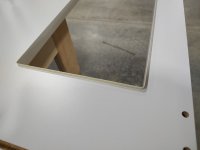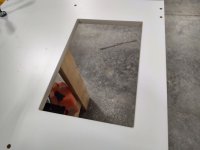Crazyraceguy
Member
- Joined
- Oct 16, 2015
- Messages
- 4,901
Trimming PVC edgebanding inside a rectangular opening of a cabinet side makes it so the "normal" horizontal base would not fit. I really prefer to cut edges with the bit cutting perpendicular to the face of the edging. Inside an opening this small (8" x 12") the router body just won't fit in there, so the work around was to mount the motor in the vertical position and use a 45 degree bevel bit. You kind of have to do it as a climb-cut, so that the bit is not trying to pull the PVC off of the material, but it's easy to cut, not grabby at all.
Dust extraction is impossible, so it made a bit of a mess, but I didn't have problems with glue sticking to the bit. There were four of these to do.
Dust extraction is impossible, so it made a bit of a mess, but I didn't have problems with glue sticking to the bit. There were four of these to do.



